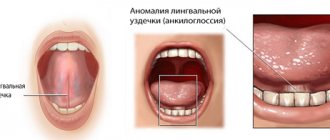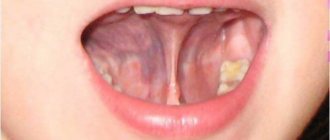Short frenulum of the tongue - parents encounter this problem around the time their baby turns 3-4 years old. He has been trying to speak for a long time, knows a lot of words, knows how to construct complex phrases, but does not pronounce some words accurately.
Grandmothers assure that in another year the child will “speak out”; mothers work with their children using special methods for early development, but the problem is not solved. If your child is still babbling at 4 years old, it is time to visit the pediatric dentist.
The frenulum of the tongue externally resembles a thin membrane, consisting mainly of connective tissue, the function of which is to attach the tongue to the bottom of the oral cavity.
In other words, a short frenulum of the tongue in a child is some kind of defect in the oral cavity that interferes with the joint movement of the tongue.
In some cases, the frenulum does not look thin at all, which significantly aggravates the situation. Almost half of all parents face this problem. And although a short frenulum can be noticed by a specialist even in newborns, parents learn about it when the baby begins to talk.
Pathology of the frenulum of the tongue can be congenital and hereditary. It should be understood that these concepts are completely different. If a congenital pathology is already present at birth, then a hereditary pathology is most often already present in one of the family members.
The concepts of complete and partial short frenulum of the tongue in a child are also distinguished. The level of discomfort of the child and the type of treatment chosen (surgical intervention or corrective exercises) depend on the type of pathology.
With a full frenulum, the child's tongue is practically immobilized, which makes it much more difficult to pronounce most speech sounds. With this type of pathology, muscle cords form. In the case of partial pathology of the frenulum of the tongue, the role of muscle cords is performed by connective tissue.
Why is a short frenulum dangerous?
A short frenulum is a congenital pathology in which the development and functionality of the ligamentous connection between the tongue and the lower jaw is disrupted. At the same time, the mobility of the tongue in the oral cavity is limited so much that it causes speech problems in the child.
Problems with the frenulum of the tongue in a child can occur in two ways. Young children who are breastfed or bottle-fed and have this pathology may have problems with sucking. This occurs due to the fact that the frenulum of the tongue is so short that it simply does not allow the tongue to function adequately.
With a short frenulum of the tongue, the baby cannot be fully breastfed, due to the fact that it is difficult for him to suck out a sufficient amount of breast milk. Therefore, in this case, immediately after the birth of the baby, he has real difficulties with feeding.
The second option for realizing the problem associated with a pathological frenulum of the tongue is speech defects and they arise much later. Partial immobility of the tongue leads to the fact that the child is not able to pronounce certain sounds correctly; his speech remains similar to babbling, “lisping.”
Questions about the article
Peter 20 years old
July 28, 2022 at 00:00
Doctor, hello. We performed a frenuloplasty operation, the operation was bloodless, the doctor did not use a scalpel. On the third day, sex occurred at night. In the morning I noticed very small specks of dried blood on the wound. Please tell me, is this dangerous? Could it be fraught with the formation of a rough scar or any other complications?
drrotov
July 29, 2022 at 15:30
No, I don't think it's dangerous. This area is healing well.
Ivan 21 years old
April 15, 2022 at 00:00
Hello. I had a quadruple operation at once: straightening the inverter (there was a downward tilt), lengthening the frenulum, complete circumcision and ligamentotomy.
drrotov
April 16, 2022 at 12:00
Great! You forgot to ask a question...
Reasons for the development of tongue frenulum pathology in a child
The formation of an anomaly associated with a short hyoid membrane begins before the birth of the child. This is preceded by negative factors, which include:
- genetic predisposition;
- infection of the fetus during pregnancy;
- viral and infectious diseases suffered by the mother during pregnancy;
- mechanical injuries to the expectant mother’s abdomen;
- the age of the expectant mother is over 35 years;
- unfavorable environmental conditions;
- the influence of other factors of unknown etiology.
How to recognize pathology in a child
A neonatologist, pediatrician, or the mother herself can recognize a pathological frenulum of the tongue in a newborn. If during the first and subsequent breastfeedings the baby experiences difficulties and cannot grasp the nipple correctly, then there is a reason to consult a doctor.
The second common sign of a pathological frenulum of the tongue in children is the occurrence of a speech defect when they begin to speak in phrases, namely at 3-4 years. Most often, with this anomaly, children do not pronounce several letters: “zh”, “sh”, “sch”, “ch”, “z”, “l” and “r”. Moreover, the sound “l” is easily pronounced if it is followed by a soft vowel, for example, “i”, “yu”, “e”, “e”, “ya”, in other cases it is simply “swallowed”. If there is incorrect pronunciation of sounds, then an examination by a speech therapist is necessary.
The most common symptoms of a tongue tie in a child are the following:
- the child is not able to reach the front teeth of the upper jaw or palate with the tip of his tongue;
- the child may have difficulty moving the tip of the tongue from one side to the other;
- the front teeth of the lower jaw may have a gap between each other;
- when the tongue is pulled forward, its tip remains flat, square or heart-shaped (that is, the front edge of the tongue seems to bifurcate);
- feeding problems in newborns.
It is important to understand that if the problem of the tongue frenulum exists, then sooner or later it will have to be solved. The sooner measures are taken, the easier and more painlessly the baby will endure them.
Features of the anatomical structure of the foreskin
The foreskin is represented by folds of skin, which are one of the elements of the protective cover covering the male penis.
One of the folds is located along the body of the latter and connects the foreskin and the head of the penis to each other. It's called a bridle. The features of this anatomical formation are such that it can stretch when the flesh moves, or during sexual intercourse, when friction is performed. In the latter case, if the frenulum is of sufficient length, the head receives additional stimulation due to slight bending. If it is too short or the skin folds do not have the desired elasticity, complete exposure of the head of the penis during erection becomes impossible, so this defect can only be identified during the boy’s puberty. Treatment of a short frenulum of the foreskin is simply necessary, since this defect is characterized by a number of extremely unpleasant manifestations for any man. The penis becomes cosmetically defective, appearing curved during erection. During sexual intercourse, a man feels pain, and the frenulum, due to excessive tension, can tear and even rupture. Due to scarring of wounds, the defect intensifies, causing disruption of erectile function, emotional distress, and even fear of sexual relations.
In what cases is it necessary to trim the bridle?
The operation of cutting the frenulum of the tongue is called frenulotomy . It is classified as simple and requires only local anesthesia.
Heavy bleeding during frenulotomy is very rare; after a couple of hours the child will be able to return to the usual rhythm of life.
If a short frenulum interferes with the newborn baby's ability to receive nutrition, it must be trimmed. The decision about surgery is made by a pediatric neonatologist.
For infants, as a rule, the operation is performed without anesthesia, since only the sublingual film of connective tissue is dissected, which has practically no blood vessels or nerve endings.
For children aged 3-5 years, surgery to cut the frenulum is performed under local anesthesia. The dentist decides whether surgery is necessary, and the speech therapist prescribes the referral.
Before the operation, the child needs to donate blood for a detailed analysis, which will display numerous indicators, including the number of platelets and the rate of blood clotting.
Surgical intervention is performed provided that the pathology is moderate or severe with limited tongue mobility. After surgery, speech therapy sessions are necessary.
There are a number of indications for frenulotomy, and limited tongue mobility is not the only one. The formation of malocclusion in a child, displacement and disturbances in the formation of the dentition, low effectiveness of speech therapy and articulation gymnastics, as well as the need to install dental implants or orthodontic structures for the child.
Pathology of the tongue frenulum does not always require surgical intervention. If the child does not experience any discomfort during breastfeeding, and his pronunciation of sounds is satisfactory, then it is likely that a speech therapist will help solve the problem. In this case, the child attends special classes, performs speech therapy exercises, articulation gymnastics, etc.
Operation techniques
There are two methods of performing tongue frenuloplasty: traditional (classical) and laser. This is a more modern and safer method. The laser allows the operation to be performed with great precision and does not cause bleeding after the procedure. In addition, there is no need for stitches, and healing time is significantly reduced. This is especially important if you need to perform laser frenuloplasty on a child: the baby will tolerate the procedure much easier.
Depending on what pathology of the frenulum is detected, the doctor uses one of three techniques: cuts the frenulum, removes it, or changes the attachment site. The number of cuts and their shape depend on the choice of technique.
Treatment methods
Problems associated with a short frenulum of the tongue can be solved with medicinal and non-medicinal methods.
Medicinal methods involve surgical intervention of varying degrees.
If the sublingual membrane requires dissection, but it is quite thin and elastic, then the doctor dissects it right at the appointment. In this case, anesthesia is not provided, since the procedure is classified as mild.
More complex types of dissection of the frenulum of the tongue include frenulotomy, which is indicated for children with thicker frenulums. Frenulotomy is performed under local anesthesia with tissue dissection and subsequent suturing.
Complications of this operation may include stomatitis, prolonged bleeding from the wound, infection in the wound, etc. After frenulotomy, the child should receive pureed food for some time, as chewing may be painful.
Non-drug treatment methods include special types of massage, exercises to correct the frenulum of the tongue, and individual sessions with a speech therapist.
Non-drug methods are recommended when the condition of the child’s tongue frenulum is not critical and allows refusal of surgery. The decision on this is made by a speech therapist, pediatrician and dentist. Classes with a speech therapist include various exercises, articulation gymnastics, tongue twisters and poems.
Since a short frenulum of the tongue causes some speech defects, classes with a speech therapist are necessary both in the postoperative period and as a correction.
A massage aimed at stretching the frenulum of the tongue includes a list of special exercises. It is important that the classes are systematic so that they give a positive result.
Massage instead of cutting the frenulum is recommended for children in two cases: if the condition of the frenulum is not so critical and the problem can be solved with non-drug treatment methods; if the frenulum is cut when the child is older (over 5 years old) and the surgery will not solve problems with speech impediment.
Ways to solve the problem
At the moment, there are several correction methods:
- Trimming the frenulum in children with a scalpel.
- Laser cutting of the frenulum under the tongue.
- Stretching through exercise.
- Removing the defect using massage.
Surgical interventions can be performed in different ways, the main methods are:
- Frenuloplasty is the removal of a flap from the tissue of a defective bridge, which is sutured to the resulting wound to increase the mobility of the tongue. Local anesthesia is required, but the damaged mucous membrane heals very quickly. Used for preschool children.
- Frenulotomy: the length of the frenulum is conventionally divided into three parts, an incision is made between the lower and middle lobes, and the edges of the mucous membrane are sutured. This method is suitable for infants.
- Frenulectomy is the same manipulation, but the frenulum is clamped with instruments. The method is suitable for five-year-old children.
In more modern clinics, trimming is performed using a laser. The dissection is carried out after treatment with an anesthetic: gel, spray. For patients, such cutting is less traumatic, damage to blood vessels is minimal - the laser simultaneously cuts the mucous membrane and causes adhesions of the affected capillaries
.
Tissue regeneration after laser trimming takes place within a few days, and you can return to your normal lifestyle an hour after the procedure. But how long you need to stay in the clinic is decided by the doctor. Complications are less common than after eliminating the defect with a scalpel.
Exercises for correcting the frenulum of the tongue and in the postoperative period
Postoperative frenulum stretching and correction exercises are aimed at developing new muscle movements of the tip of the tongue inside and outside the mouth. Regular practice will increase the range of movement of the tongue.
Articulation exercises by themselves will not improve speech and will not be able to correct the defect, so it is very important to carry them out in conjunction with individual speech therapy sessions.
The most common and universal exercises for stretching and correcting the frenulum of the tongue are given here in the article. Following them, you can study at home with your child on your own:
- Stretch your tongue forward, then stretch the tip up to your nose, then down to your chin. Relax, repeat the exercise several times (at first, up to five repetitions are enough, gradually the number of repetitions must be increased, bringing them to twenty).
- The exercise is performed by analogy with the previous one, moving the tongue left and right. The number of repetitions is also gradually increased to twenty.
- Open your mouth wide. Use the tip of your tongue to touch the upper incisors and try to press on the teeth with all your might, not allowing your mouth to close. During each execution, mentally count to ten. The number of repetitions is the same as the previous ones.
- The exercise is performed in front of a mirror. The mouth is wide open. When performing the exercise, it is important to monitor the movements of the tongue. Pronounce the syllables “dar-dar-dar”, “nar-nar-nar”, “tar-tar-tar”, etc.
- Sticking your tongue forward as much as possible, alternately “lick” your upper and lower lips.
- Closing your mouth, move your tongue from right to left and back, forcefully pressing the inside of your cheeks with the tip of your tongue.
To achieve good results, exercises should be performed daily, in several approaches, for 15-20 minutes . The articulation of specific sounds can be gradually corrected.
Important! You can begin to perform exercises for the frenulum of the tongue only after the wound has completely healed.
Speech therapy classes should include exercises to improve the functioning of the speech apparatus and oral kinesthesia, without which it is difficult to claim significant improvements in the development of a child’s speech. Many young patients, after cutting the frenulum, begin to speak more quietly and more quickly, trying to “drown out” speech problems.
Classification of frenulotomy
The presented operation takes very little time, but at the same time provides a 100% result in solving the main problems with the functioning of the frenulum. To implement your plan, you don’t even have to use general anesthesia, because you will be able to limit yourself to a local solution that is safer for the cardiovascular system. The injection is given into the penis itself and after a few minutes you can operate. If the victim has not reached the age of eighteen, then he is given anesthesia intravenously.
The procedure, even including pain relief, lasts no more than twenty minutes.
The exact date will be announced by the specialist, based on the chosen treatment method. In total, there are a duet of variations of surgical intervention for these purposes:
- classical;
- laser.
The traditional proposal relies on the use of a surgical scalpel. Despite the development of modern technologies with a variety of thematic innovative equipment, it is the scalpel technique that is still the most in demand. The only possible drawback here is extensive blood loss compared to the laser analogue and the risk of tissue infection. But in the latter case, doctors simply recommend contacting clinics with a proven reputation in order to mitigate such risks.
Those who want to get an ideal result with minimal blood loss choose the laser approach. It is believed that the rays generated by such a device have a gentler effect on tissue than a scalpel. The technical safety of the method is explained by the fact that the rays trigger the coagulation of cells and blood vessels, which provokes the evaporation of liquid instantly. Due to this, the recovery period is much easier to bear, and the incision sites remain almost invisible to the naked eye.
But the advantage of the technique can become its significant disadvantage. For the absence of visible seams, you will have to pay the price of keeping the penis completely calm during the rehabilitation period. As soon as even a slight erection begins at the recovery stage, the welded tissues will separate. Sometimes the erection process starts even unconsciously in patients, so doctors have to remind them of the need to fix the position. Otherwise, repeated divergence of the soldered section threatens the formation of a rough scar.
But with a laser solution, you don’t have to worry about infection, which was made possible thanks to the ability of the laser beam to make a cut by heating up to 400 degrees Celsius. Some ordinary people believe that the issue of infection is nothing more than a horror story. But statistics say that about 10% of possible complications after surgery are due to the development of inflammation due to infection.
But even if everything went as smoothly as possible, there is still a chance of complications such as:
- pain syndrome;
- swelling;
- bleeding;
- scarring.
The finished result does not always satisfy the patient from an aesthetic point of view, which most often has its roots in the unprofessionalism of the specialist or the congenital pathologies of the victim.
Most of the side effects can be neutralized on an outpatient basis, which means there is no mandatory hospitalization. To relieve pain, the doctor will prescribe suitable analgesics, and specialized ointments are used to level out extensive swelling.











